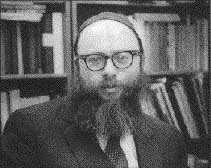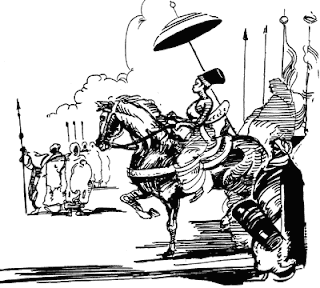Who is the Sephardi and who is the Ashkenazi?
This is not just a simple trivia question but rather an interesting story (I should say two very interesting stories) lies therein.

I originally thought that Rabbi Kaplan- scion of an old Sephardic family (see excerpt later) completely assmilated into the Ashkenazic (chiefly Lithuanian Yeshiva) mileu in which he was raised most of his life. Rabbi Yaakov Shaul Elyashar -on the other hand (bottom photo) was of (partial) Ashkenazic parentage; his mother remarried a Sephardic Rabbi -after his father died- who had a major influence on the young Yaakov Shaul (then all of 7). He was raised among the Sephardim eventually being appointed Chief Rabbi of the Sephardic community (Rishon Leziyyon). However, it appears that the Elyashars are of Turkish Sephardic ancestry, the only apparent Ashkenazic connection is the latter's grandmother (father's mother) was the daughter of a Rabbi Yeruham from Vilna.
Actually I have come across conflicting information on R. Elyashar. One search turned up this:
רבי יעקב שאול ב"ר אליעזר ירוחם
אלישר. נקרא בפי כל 'יש"א ברכה' (ר"ת משמו). כיהן כרב ראשי וכראשל"צ בירושלם משנת תרנ"ג עד שנתבש"ם בתרס"ו. נכד המקובל ר' ירוחם מווילנא ונין לר' יעקב אשכנזי מווילנא. נולד בצפת ביום כ"ג סיון תקע"ז.
בהיותו בן שבע נתיתם מאביו ואח"ז אמו נישאה לרבי מרדכי נבון (בעל "נחפה בכסף") ויהי לו לאב ולרב. ומאז נתגדל בין חכמי הספרדים ויהי כאחד מבני עדתם, עד כי נמנה לרבם הראשי.
Short synopsis:
Rabbi Yaakov Elyashar - who was later to become the Rishon Leziyyon was descended of Rabbi Yerucham of Vilna , who in turn was descended of R' Yaakov Ashkenazi of Vilna. He (Yisa Bracha) was orphaned at the age of Seven when his father died. His mother then remarried to the Chacham Mordechai Navon who became his stepfather and mentor. From that point on he was raised among the sephardim and 'he became like one of them' untill he was appointed their Chief Rabbi (Rishon Leziyyon).
In the Wikipedia http://he.wikipedia.org/wiki/%D7%9E%D7%A9%D7%A4%D7%97%D7%AA_%D7%90%D7%9C%D7%99%D7%A9%D7%A8 entry for the Elyashar family- however:
ר' חיים יוסף אליישר - נשא לאשה את ביתו של ר' יעקב וילנא. ייתכן ומכאן הטעות בקשר למוצא המשפחה
Translation: Reb Chaim Yosef Elyashar (the paternal Grandfather of the Yisa Bracha) married the daughter of Rav Yaakov Vilna. It is possible that from this originates the erroneous belief as the (Ashkenazic) origin of this family
So in summation, it appears that the Yisa Bracha was indeed descended from Rav Yaakov Vilna but only through the maternal line and the origins of the Elyashar (or Elisar) family lie in Sepharad.
So in conclusion, both Rabbis Elyashar and Kaplan are of mixed Sephardi-Ashkenazi parentage (Ashkefardi?).
Rabbi Aryeh Kaplan mentions his Sephardic ancestry in the introduction to his Passover Haggadah:
He writes:
A number of people have inquired about the parenthesized "Carmona" after my name. This was the original family name of my paternal grandfather, Rabbi Yosef Kaplan (Carmona). The name denotes the place from which out family originated, a city in southern Spain, not far from Seville. Upon arriving in the United States around the turn of the century my grandfather changed his name to the more Ashkenazic sounding Kaplan for business reasons. (Incidentally, "kaplan" means tiger in Turkish.) Although I was educated in Ashkenazic yeshivoth such as Torah Vodaath and Mir, I have maintained a strong link with my Sephardic background. The MaAm Lo'ez project merely brings it full cycle.
Labels: ashkenazim, rabbi aryeh kaplan, rabbi yaakov elyashar, sephardim
















